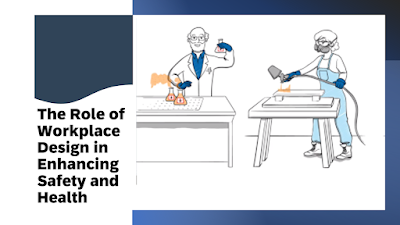The Role of Workplace Design in Enhancing
Safety and Health
The Role of
Workplace Design in Enhancing Safety and Health
The design of a
workplace can have a significant impact on the health and safety of employees.
A well-designed workplace can help reduce the risk of incidents, injuries, and
illnesses, while also improving overall employee well-being and productivity.
In this article, we will explore the importance of workplace design in
enhancing safety and health and discuss some key factors to consider when
designing a safe and healthy workplace.
Hearing Protection Safety Why It Matters
Workplace Design and Safety
The properly designed workstation helps the employees to work safely and effectively which yields maximum production. Workplace design plays a critical role in ensuring the safety of employees. A poorly designed workplace can create hazards that increase the risk of incidents and injuries. For example, cluttered workspaces, poorly lit areas, and inadequate ventilation can all contribute to incidents and illnesses. Workplace illumination is also an important factor for effective working, the adequate lighting to be maintained. The standard requirements of illumination at various areas to be ensured.
On the other hand, a
well-designed workplace can help prevent incidents and promote safety. An
ergonomic workspace, for example, can reduce the risk of musculoskeletal
disorders and repetitive strain injuries. Good lighting and ventilation can
improve air quality and reduce the risk of respiratory illnesses. Well-designed
emergency exits and clear signage can help employees evacuate quickly and
safely in the event of an emergency. The good designed workstation or equipment
will help to reduce the repetitive action which resulting many occupational
illness and injuries.
In addition to physical safety, workplace design can also impact psychological safety. An open, collaborative workspace can foster a sense of community and teamwork, while a closed, isolated workspace can create feelings of loneliness and disconnection. When employees feel supported and connected to their colleagues, they are more likely to feel safe and engaged at work.
Workplace Design and Health
Workplace design can also have a significant impact on the health of employees. A healthy workplace can help prevent chronic illnesses, reduce stress, and promote overall well-being. The control measures taken for reducing the occupational illness or injuries will help employees to work more effectively and reduce the absenteeism from duty.
One key factor to
consider when designing a healthy workplace is ergonomics. Ergonomic design
focuses on creating workspaces that are comfortable and efficient, reducing the
risk of musculoskeletal disorders and other health issues. Examples of
ergonomic design include adjustable desks and chairs, proper keyboard and mouse
placement, and anti-fatigue mats.
Another important factor in promoting health in the workplace is the availability of healthy food options. The junk foods & excessive cool drinks may cause the headache, stomach concerns et c to the employees. Health management team should give awareness session on the healthy food habits to all employees. A workplace that provides healthy snacks, fresh fruit, and other nutritious options can help employees maintain a healthy diet and reduce their risk of chronic illnesses such as diabetes and heart disease.
In addition to
physical health, workplace design can also impact mental health. A
well-designed workplace can reduce stress and promote a positive work
environment. Examples of design elements that can improve mental health include
natural light, access to outdoor spaces, and quiet areas for relaxation and
meditation.
Key Factors to Consider in Workplace Design
When designing a safe and healthy workplace, there are several key factors to consider. These include:
Ergonomics: As previously mentioned, ergonomic design is critical in promoting physical health and preventing injuries. Consider adjustable desks and chairs, proper keyboard and mouse placement, and anti-fatigue mats. The detailed study to be done for the workstation and workplace before the installation and all the control measures to be ensured in the design aspects.
Lighting: Good lighting is essential for promoting safety and reducing eye strain. Make sure workspaces are well-lit and consider natural lighting options.
Ventilation: Proper
ventilation is important for maintaining good air quality and reducing the risk
of respiratory illnesses. Ensure that workspaces have adequate ventilation and
air filtration systems.
Noise: Noise levels can impact employee stress and productivity. Consider acoustic design elements such as sound-absorbing panels and white noise machines to reduce noise levels. Excessive noise and prolonged exposure lead to noise induced hearing loss to employees.
Movement: Encourage movement and physical activity by providing opportunities for exercise and movement breaks throughout the workday.
Safety: Ensure that
emergency exits are clearly marked and accessible, and that there are adequate
fire safety measures in place.
Community: Foster a sense of community and connection among employees by designing open, collaborative workspaces and providing opportunities for social interaction.
It is important to note that workplace design is not a one-size-fits-all solution. The needs and preferences of employees may vary depending on the industry, job function, and individual differences. Employers should consult with their employees to understand their needs and preferences when designing a safe and healthy workplace.
In addition,
employers should also regularly evaluate and update their workplace design to
ensure that it continues to meet the needs of their employees. As technology
and work practices evolve, workplace design should also evolve to meet the
changing needs of the workforce.
Ensuring Safety at Heights in Industry
Conclusion
Workplace design is
a critical factor in enhancing safety and health in the workplace. By
considering key factors such as ergonomics, lighting, ventilation, noise,
movement, safety, and community, employers can create a safe, healthy, and
productive work environment for their employees. A well-designed workplace can
help prevent accidents and illnesses, reduce stress, and promote overall
well-being and productivity.

No comments:
Post a Comment